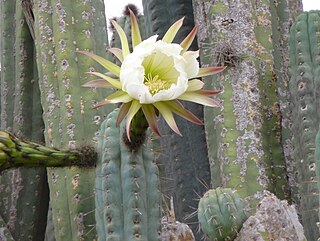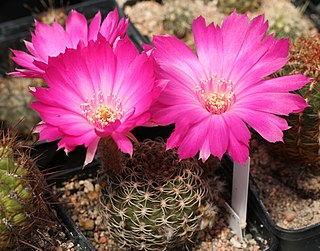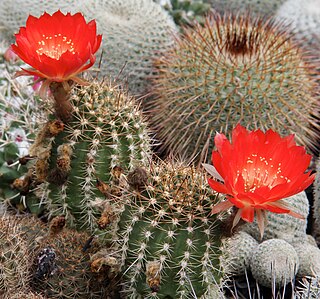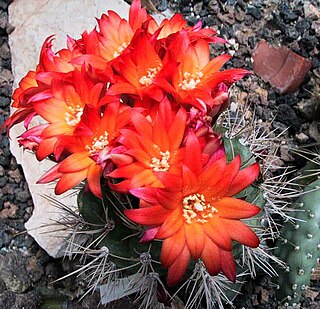
Oreocereus is a genus of cacti, known only from high altitudes of the Andes. Its name means "mountain cereus", formed from the Greek prefix oreo- and the Neo-Latin cereus, meaning wax or torch.

Weingartia is a genus in the family Cactaceae, with species native to Bolivia and Argentina. Molecular phylogenetic evidence suggests that it may be distinct from Rebutia. It is treated as a synonym of that genus by Plants of the World Online as of September 2023, but recognized as an alternative generic name in the third edition of the CITES Cactaceae Checklist. It may also be treated as Rebutia subg. Weingartia.

Echinopsis lageniformis, synonyms including Echinopsis scopulicola and Trichocereus bridgesii, is a cactus native to Bolivia. It is known as the Bolivian torch cactus. Among the indigenous populations of Bolivia, it is sometimes called achuma or wachuma, although these names are also applied to related species such as Trichocereus macrogonus which are also used for their psychedelic effects.

Cleistocactus winteri is a succulent of the family Cactaceae. Its common name is the golden rat tail. Cleistocactus winteri subsp. colademono, as its synonym Cleistocactus colademononis, has gained the Royal Horticultural Society's Award of Garden Merit.

Strophocactus brasiliensis is a species of cactus also known by its synonym Pseudoacanthocereus brasiliensis. It is endemic to Brazil. Its natural habitats are tropical and subtropical dry broadleaf forests and savanna. It is threatened by habitat loss.

Rapicactus zaragosae, synonym Turbinicarpus zaragosae, is a species of plant in the family Cactaceae. It is endemic to Mexico. Its natural habitat is hot deserts. It is threatened by habitat destruction.

Espostoa melanostele is a species of rare, endangered, long-lived, slow-growing plant in the family Cactaceae.

Copiapoa atacamensis is a species of cactus from the Atacama Desert in the province of Antofagasta in northern Chile. Its relationship with other species of Copiapoa, such as C. calderana, is unclear as of April 2012.

Lobivia backebergii is a species of flowering plant in the cactus family Cactaceae, native to eastern Bolivia and southern Peru.

Espostoa frutescens is a plant in the family Cactaceae.

Armatocereus rauhii is a tall, branched columnar species of cactus endemic to the north of Peru on the western slopes of the Andes.

Lobivia hertrichiana is a species of Lobivia found in Bolivia and Peru.

Matucana intertexta is a species of cactus in the genus Matucana, native to Peru. It has gained the Royal Horticultural Society's Award of Garden Merit.

Neowerdermannia chilensis is a species of Neowerdermannia found in Argentina, Bolivia, Chile, and Peru.

Matucana aureiflora is a species of Matucana found in Peru.

Matucana oreodoxa is a species of Matucana found in Peru.

Weberbauerocereus albus is a species of Weberbauerocereus from Peru.

Weberbauerocereus winterianus is a species of Weberbauerocereus from Peru.

Loxanthocereus xylorhizus is a species of Loxanthocereus found in Peru.
Weberbauerocereus churinensis is a species of cactus in the genus Weberbauerocereus, native to Peru.




















